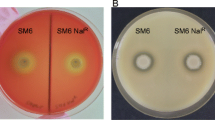Abstract
The potential pathogenicity of one isolate each of Cladosporium tennuisimum, Phaeoisaria clematidis and Ramichloridium subulatum for mice was investigated by intravenous, intraperitoneal and subcutaneous routes of inoculation with saline and mucin suspensions of the organisms. No mice died during the experimental period. Dark nodular lesions were formed in the liver, spleen, kidneys, intestine, stomach, omentum and diaphragm after inoculation through the intravenous and intraperitoneal routes. Gross lesions were produced in the lungs of one mouse inoculated intravenously with R. subulatum. Localised nodular lesions were formed in the subcutis following the subcutaneous route. Tissue response was characterised by granulomatous inflammatory reaction. Fungal elements were confined within the granulomata. Though the fungi showed limited pathogenic potential, they may represent a hazard under conditions of compromised host immunity.
Similar content being viewed by others
References
Dixon DM, Salkin I. Morphologic and physiologic studies of 3 dematiaceous pathogens. J Clin Microbiol 1986; 24: 12–5.
Douer D, Goldschied-Reouven A, Seger S, Ben-Bassat I. Human Exserohilum and Bipolaris infections: report of Exserohilum nasal infection in a neutropenic patient with acute leukemia and review of the literature. J Med Vet Mycol 1987; 25: 235–41.
McGinnis MR, Rinaldi MG, Winn RE. Emerging agents of phaeohyphomycosis: pathogenic species of Bipolaris and Exserohilum. J Clin Microbiol 1986; 24: 250–9.
Fukushiro R, Udagawa S, Kawashima Y, Kawamura Y. Subcutaneous abscess caused by Ochroconis gallopavum. J Med Vet Mycol 1986; 24: 175–82.
Matsumoto Y, Padhye AA, Ajello L, McGinnis MR. Sarcinomyces phaeomuriformis: A new dematiaceous hypohomycete. J Med Vet Mycol 1986; 24: 395–400.
Padhye AA, Helwig WB, Warren NG, Ajello L, Chandler FW, McGinnis MR. Subcutaneous phaeohyphomycosis caused by Xylohypha emmonsii. J Clin Microbiol 1988; 26: 709–12.
Okeke CN. Some aspects of ecology, physiology and pathogenicity of dematiaceous fungi. [PhD thesis]. Nsukka, Nigeria: University of Nigeria, 1987.
Okeke CN, Gugnani HC. Studies on pathogenic dematiaceous fungi. I. Isolation from natural sources. Mycopathologia 1986; 94: 19–25.
Matsumoto Y, Matsuda T. Chromoblastomycosis and phaehyphomycosis. Seminars in Dermatol 1985; 4: 240–50.
Gugnani HC, Obiefuna MN, Ikerionwu SE. Studies on pathogenic dematiaceous fungi. II. Pathogenicity of Fonsecaea pedrosoi and Phialophora verrucosa for laboratory mice. Mykosen 1986; 29: 505–15.
Polak A. Experimental infection of mice by Fonsecaea pedrosoi and Wangiella dermatitidis. J Med Vet Mycol 1984; 22: 168–9.
Author information
Authors and Affiliations
Rights and permissions
About this article
Cite this article
Okeke, C.N., Gugnani, H.C. & Onuigbo, W.I.B. Potential pathogenicity of Cladosporium tennuisimum, Phaeoisaria clematidis and Ramichloridium subulatum in a mouse model. Mycopathologia 114, 65–70 (1991). https://doi.org/10.1007/BF00436423
Received:
Accepted:
Issue Date:
DOI: https://doi.org/10.1007/BF00436423




